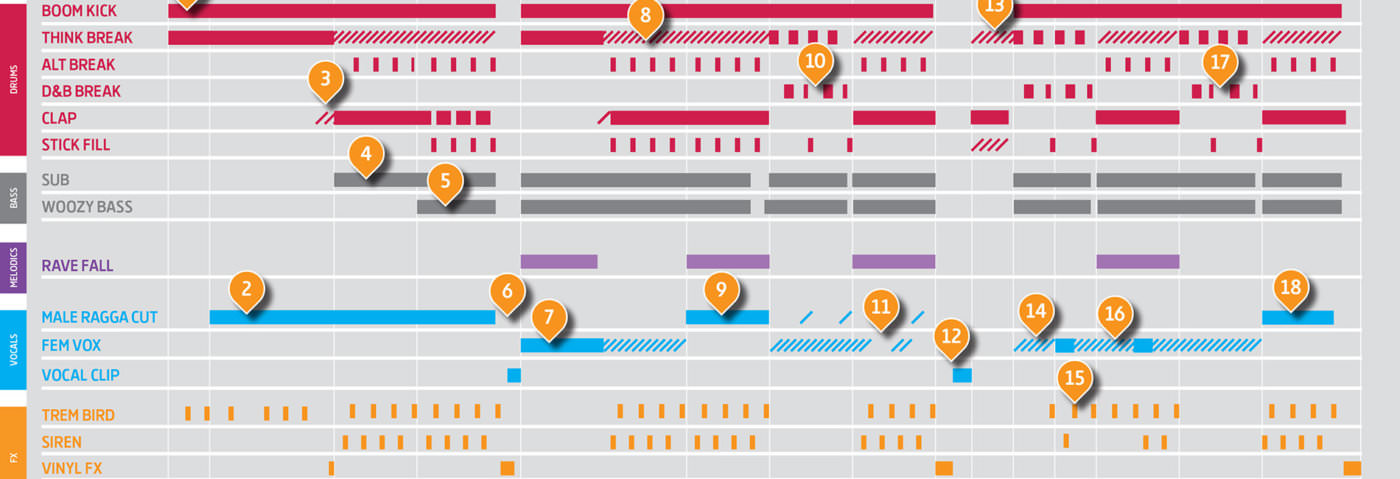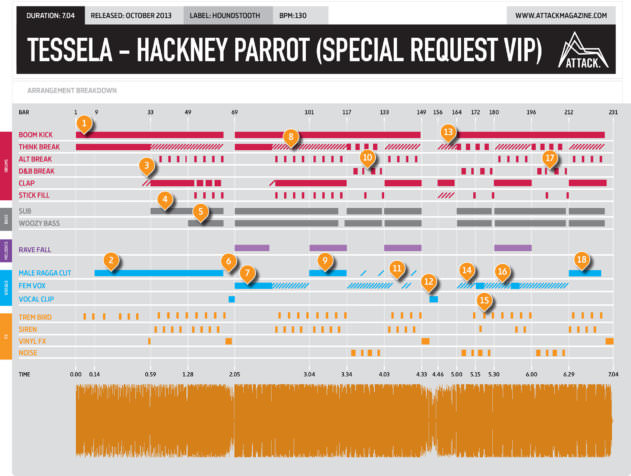We deconstruct the arrangements of tracks to see what we can learn from their structure.
This month we deconstruct Paul Woolford’s Special Request VIP remix of Tessela’s ‘Hackney Parrot’ – seven minutes of cut-and-paste mayhem featuring an eclectic mix of sounds and samples from jungle and rave to classic UK house.
The track
The arrangement
What’s happening
1. The track opens with the main drum break that will underpin the groove. It’s a sample of the classic break from Lyn Collins’s ‘Think’, edited, sliced, then fed into a blossoming echo that spins delays around the stereo spectrum. A heavily reverberated, booming kick fills out the low end. A warbling dub siren sound effect preempts each turnaround (trem bird in the graphic).
2. Enter the sampled ragga vocals, taken from an open vocal line on a remix of Top Cat’s ‘Request The Style’. Note the muting of the second (of four) sirens to clear space for detail in the new vocal element. While the track is generally governed by eight-bar or 16-bar turnarounds, this opening section lasts for 24 bars to make it more DJ-friendly.
3. A simple fill, consisting of a clap pattern underpinned by a short vinyl slowdown, marks the end of the intro and foreshadows the entry of the sub bass.
4. It’s all change as the track suddenly gets much busier. The Think break is chopped more liberally in order to rearrange the groove. It’s joined by a machine-sourced clap, ping-pong delayed, and a second alternative break (most likely a different edit of the Think break), triggered in the latter part of each measure and EQd differently to provide a counterpoint to the main Think part. Only the boom kick is left untweaked to deliver a single long hit at the start of each bar. Elsewhere, a sparse sub bass part fills out the low end while a synth siren, heavily delayed, offers mid-range detail at different times to the FX.
5. A big woozy bass, drifting lazily between notes now fills out the bass frequencies. Its brutal simplicity allows space for the drum groove to retain the central focus, with a lively stick/rimshot fill at the end of each turnaround. At various points in the track, other rhythm parts are silenced to allow this part to perform its unchanging fill alone.
6. At bar 65, all elements are silenced as a vinyl spinback makes way for a short spoken word clip, taken from a recording of Kenny Ken and GQ at AWOL at the Paradise Club in London in 1994. “Check… As we wheel and come again for the massive dem.” We’ll hear more from the same sample source later in the track.
7. Four bars later the woozy bass re-enters, this time playing a slightly more complex melody. The beat returns to play the opening Think break sequence, shifting all attention to the floor-shaking bassline. The upper registers are dominated by two newcomers: firstly the re-worked female vox sample (the legendary Kathy Brown, sampled from an acapella of ‘Turn Me Out’) and a simple old-school rave fall that triggers when the vocal is absent. Note the muted FX lines; slimming them out of the mix gives the new elements space to assert themselves.
Note the muted FX lines; slimming them out of the mix gives the new elements space to assert themselves.
8. Here we get the previous 16-bar section again, but this time it’s comprehensively twisted. Only the boom kick and basslines are left untouched as the Think break is cut and rearranged, while the stick fills and claps are reintroduced for end-of-measure flourishes. The vocal is also given the cut-and-paste treatment; its sequence is liberally reordered with occasional spot delay spins fading tails into the mix, using a mix of tape and ping-pong delays. The reintroduction of the FX bird and siren add to the mayhem.
9. The male vox returns, joining the same bass sequence that it last played with at bar 49 (this coupling of parts is common throughout the arrangement). The rave fall joins the FX, while the various rhythmic elements continue their relentless interplay. The 16-bar section rounds off with a bassline dropout – with the woozy bass only reappearing a bar before the next turnaround.
10. Bassline sequence two (debuted at bar 69) returns with its vocal pairing, the Kathy Brown vox sample – once again, heavily effected. Listen out for two brief flurries of the male ragga vox (a staple of Paul Woolford’s productions under his Special Request alias) to keep things changing. Most prominent is a new beat element – a third breakbeat with a more obviously D&B vibe. Like the alt break, it’s triggered during the second and fourth bars of each four-bar phrase, with the Think break opening bars one and three. Also new in the mix is the rough ‘noise’ FX that plays beneath the D&B break, a coarse found-sound sample that delivers a rising sense of claustrophobia which dissolves with the start of each new bar.
11. The bass elements drop for a bar and then back come the clap, rave stab and FX, providing a modicum of continuity as elsewhere mayhem unfolds, the female vocal edits in particular getting ever more insistent, rallied by myriad beat edits.
12. A vinyl spin fades to echo before the second spoken word clip of the track, taken from the same Kenny Ken and GQ set: “Right, listen. I’ve just been told, anybody’s got a Fiesta parked inside the market, you best move it or you’re walking home. Right? Come with the music.” It’s one of the most recognisable moments of the track, providing a brief respite before the final section. From a structural point of view it’s worth noting that this short section lasts only seven bars, shifting the whole arrangement ‘forward’ a bar.
13. The rhythmic break is made up of a heavily edited version of the Think break, this time not just sample start and end points being messed with but pitch envelope too. The sticks make a one-off change from their usual sequence to reinforce the new groove. The clap is left to play straight off-beats. In a track defined by its energy, this and the previous spoken word clip are about as close as we get to a breakdown.
In a track that is defined by energy, this and the 149-156 spoken word clip is about as close as we get to a breakdown.
14. It’s time for another Think/D&B break combination, female vocals getting the now trademark retrigger and fade-to-nothing treatment.
15. Echoing the earlier shift in energy highlighted in step eight, bars 172-180 use the framework established in bars 164-172 and embellish it with added FX. Note the instance of the female vocals that open the section. The reappearance of these straight mix elements adds a note of the unexpected to proceedings and keep things engaging. Second guessing what’s going to happen next in this mix is absolutely not on the cards. A stick fill carries the track to bar 188, with the bass muted to let it shine.
16. The mix fills out even more as the female vocals are tweaked yet further, reverb and delay levels morphing between in-your-face dry to swamped wet. The rave stab adds interest in the upper mids, with the siren joining the action at bar 188. The clap fills out the rhythm section for what is the last big blast of the song.
17. The mix simplifies for a last staging of the breakbeat combo. With the rave stabs and FX muted, all attention is on the beat and bass. Even the vocals are toned down, with the mayhem dialled down to signal the approach of the end.
18. For the outro, the male ragga vocal returns for one last flourish, with the FX adding circularity to the mix. A long vinyl backspin, with a subtle delay halo, rounds things off.


12.33 PM
Absolutely love these deconstructions, this one in particular as Paul Woolford is one of my favourite producers currently. Love the detail and how you guys explain what each component of the track does. Gives you a real insight into how Paul made the track in my opinion.
08.02 PM
I also realy these deconstructions 🙂
07.58 AM
Is the splice file meant to have no audio and just show the arrangement or is it supposed to have samples with it?
08.10 AM
No, Jonesy,
Splice file is only meant to show the arrangement. Some users download and use as starting point for their own tracks.
Dave